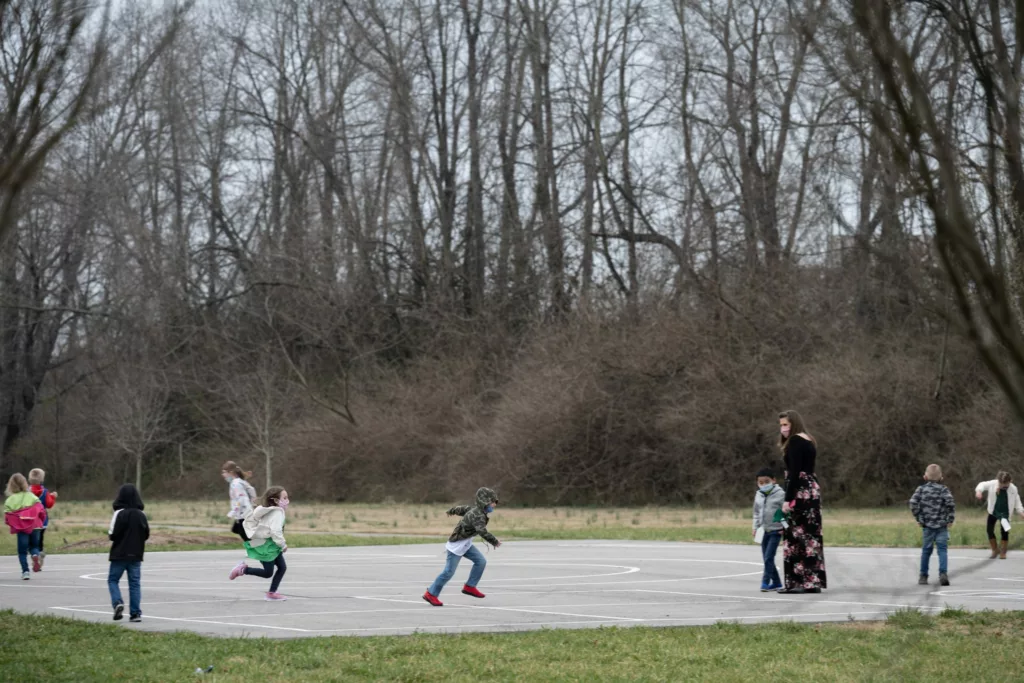[ad_1]
Get important education news and analysis delivered straight to your inbox
Editor’s note: This story led off this week’s Early Childhood newsletter, which is delivered free to subscribers’ inboxes every other Wednesday with trends and top stories about early learning. Subscribe today!
Recess is a critical time for children, a time for play that can benefit both their behavior and academics. But it isn’t joyful for all children. Without the right oversight and planning, recess can be stressful for some kids, especially for those who are shy, anxious or targeted by bullying.
“Students may come back from recess feeling dissatisfied … feeling excluded,” said Rebecca London, an associate professor of sociology at the University of California, Santa Cruz and the author of the book “Rethinking Recess,” when I interviewed her for a story about recess last year. “We can’t just say, ‘Throw everyone out in the rec yard with a couple of balls’…There has to be an intentionality as to how we set our recess up to serve the needs of children.”
Research backs this up: The quality of the recess experience, including the availability and inclusivity of games, adult engagement and students’ ability to resolve conflict, are essential factors in making recess a positive experience for all children.
At The Hechinger Report, we’ve spent the last year reporting on the importance of recess and play. But how can schools make sure their recess time is fun for all? For guidance, I reached out to Laura Medina Quintanar, executive director of the Northern California region for the nonprofit Playworks. The organization has worked with more than 3,500 schools nationwide to improve safety, engagement and inclusion during recess. Here are three things schools can do to make sure all kids reap the benefits of that play time:
- Create some light structure to recess: At schools that work with Playworks, recess includes formal games, like “blob tag” or the “bullfrog game,” led by a coach or an older student, as well as free play. The presence of structured games can help students feel they have options at the playground, especially if they aren’t sure where they fit in during recess. “We’re not forcing kids to play, it’s not rigid,” Medina Quintanar said. “It’s more about focusing on creating opportunities for students to jump in, and feel safe jumping in.” Coaches also focus on building a culture of positive language during these games, saying things like “good job” and “nice try” instead of “you’re out” or more punitive terms.
- Build a repertoire of school-wide games and teach students those rules: Beyond recess, classes at Playworks schools take time to go outside and learn new games during the week, many of which are available through the nonprofit’s online game library. While this time serves as a brain break for kids, it also ensures kids have plenty of ideas for play at recess. “That’s a tangible tool that we know diminishes the chaos or lack of organization,” Medina Quintanar said. Even if a coach is not there to lead them, once students learn a game, and they all know how to play it, they can get together on their own to start the game. “When your first grader goes out to recess, they’re already familiar with it and feel more comfortable jumping in,” Medina Quintanar said. Teaching the rules of the games in advance also eases the load of teachers who might otherwise be asked to facilitate every game.
When I spoke to Rebecca London, the UC sociology professor, last year, she also encouraged schools to create a set of school rules for recess games. Rules can “mitigate that tension around that game,” London said, so kids don’t spend time fighting about how to play.
- Encourage student leadership at recess: Playworks encourages older students, called “junior coaches,” to lead games with younger children. Many of the students selected as coaches haven’t had leadership roles before or might not be naturally inclined to lead others. “A big piece of this is empowering students,” said Medina Quintanar, so that they feel comfortable organizing games with each other and encouraging other students to jump in and play. While not all schools have equipment like balls and hula hoops, motivating students to take ownership of available materials can help give kids purpose and build leadership skills and confidence around play time, she added. Playworks encourages students to bring materials out to the playground and then collect items when play time is over.
Providing kids a positive recess experience is not always easy. It takes time and willpower to set up recess so it is an inclusive, productive time for students. School officials and educators may need to shift their mindset around recess to recognize the value of play, Medina Quintanar said. “It’s really important that [recess] is not overlooked,” she said. “It’s not just releasing kids into the yard and they fend for themselves until it’s time to come back,” she added. “Everyone benefits when students have a positive recess experience.”
This story about recess problems was produced by The Hechinger Report, a nonprofit, independent news organization focused on inequality and innovation in education. Sign up for Hechinger’s newsletter.
[ad_2]
Source link
Meet Our Successful Graduates: Learn how our courses have propelled graduates into rewarding
careers. Explore their success stories here!
Discover More About Your Future: Interested in advancing your teaching career? Explore our
IPGCE, MA, and QTS courses today!

Explore Our Courses: Ready to take the next
step in your education journey? View our
comprehensive course offerings now!

